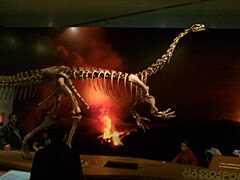| Massospondylus Temporal range: Early Jurassic,
| |
|---|---|

| |
| Reconstructed skeleton on display in the Royal Ontario Museum | |
| Scientific classification | |
| Domain: | Eukaryota |
| Kingdom: | Animalia |
| Phylum: | Chordata |
| Clade: | Dinosauria |
| Clade: | Saurischia |
| Clade: | †Sauropodomorpha |
| Clade: | †Bagualosauria |
| Clade: | †Plateosauria |
| Clade: | †Massopoda |
| Family: | †Massospondylidae |
| Genus: | †Massospondylus Owen, 1854 |
| Species | |
| Synonyms | |
|
List
| |
Massospondylus (/ˌmæsoʊˈspɒndɪləs/ mas-oh-SPON-di-ləs; from Greek, μάσσων (massōn, "longer") and σπόνδυλος (spondylos, "vertebra")) was a genus of sauropodomorph dinosaur from the Early Jurassic (Hettangian to Pliensbachian ages, ca. 200–183 million years ago). It was described by Sir Richard Owen in 1854 from remains discovered in South Africa, and is thus one of the first dinosaurs to have been named. Fossils have since been found at other locations in South Africa, Lesotho, and Zimbabwe. Material from Arizona's Kayenta Formation, India, and Argentina has been assigned to the genus at various times, but the Arizonan and Argentinian material are now assigned to other genera.
The type species is M. carinatus; seven other species have been named during the past 150 years, but only M. kaalae is still considered valid. Early sauropodomorph systematics have undergone numerous revisions during the last several years, and many scientists disagree where exactly Massospondylus lies on the dinosaur evolutionary tree. The family name Massospondylidae was once coined for the genus, but because knowledge of an early sauropod relationship is in a state of flux, it is unclear which other dinosaurs—if any—belong in a natural grouping of massospondylids; several 2007 papers support the family's validity.
Although Massospondylus was long depicted as quadrupedal, a 2007 study found it to be bipedal. It was probably a plant eater (herbivore), although it is speculated that the early sauropodomorphs may have been omnivorous. The genus was 4–6 metres (13–20 ft) long, and had a long neck and tail and a small head and slender body. On each of its forefeet, it bore a sharp thumb claw that was used in defense or feeding. Recent studies indicate that Massospondylus grew steadily throughout its lifespan, possessed air sacs similar to those of birds, and may have cared for its young.